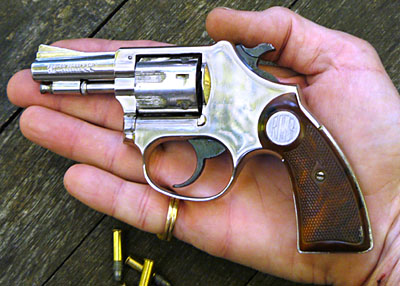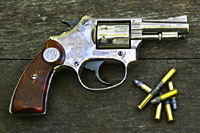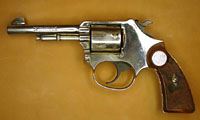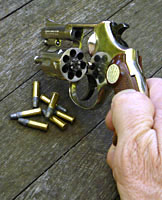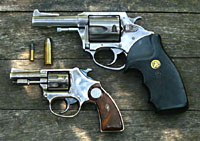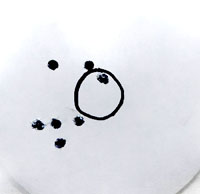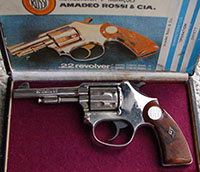 |
||||||||||||||||||||||||||||||||||||||||||||||||||||||||||||||||||||||||||||||||||||||||||||||||||||||
|
The Rossi Princess Revolver
There is very little in print about the Rossi Princess revolver. At the time of this writing, it does not appear in the Bluebook of Gun Values or the Standard Catalog of Firearms. I could find no mention of older Rossi firearms, such as the Princess, on the company’s U.S. or Brazilian websites. I find the gun first listed in Gun Digest in 1966, where it is described as the Rossi Ladysmith, imported by Benet Arms. Most examples I have seen are stamped FIREARMS INT’L CORP., WASHINGTON, D.C. Rossi firearms were later imported by Interarms, but I don’t believe they ever imported the Princess.
Pete Dickey’s article in the September 1982 issue of American Rifleman states the Princess’s frame is die cast from “Zamak,” a zinc-based alloy which incorporates aluminum, magnesium, and copper. Zamak is often denigrated as potmetal. However, it has been pointed out to me by an engineer friend that Zamak is a family of alloys and that the strongest one, Zamak 2, is substantially stronger than commonly-used high strength aluminum alloys, though I am told by an informant in Brazil that the Princess revolver is made from Zamak 4. The weak point is the area of the frame above the gap between the cylinder and barrel. The barrel has a steel liner and the cylinder is also made of steel. The Princess was manufactured from 1957 through 1984, but was only imported into the United States from 1965 through 1969—a victim of the Gun Control Act of 1968. Based on serial numbers, about 953,000 were made.* It was available with a 2- or 3-inch barrel, in nickel finish only. The 2-inch barrel version was designated by Rossi as the Model 25, and the 3-inch barrel version as the Model 13. When the gun first hit the U.S. market it seems to have been called a Ladysmith by default, but another trade name was needed for it and some marketing genius decided on “Princess.” A less-macho appellation could not have been had, but I suppose some similar name was inevitable given the gun’s diminutive size and resemblance to the Ladysmith. The serial number is on the base of the grip. The gun is marked on the left side of the barrel: S. LEOPOLDO R.G.S. The right side of the barrel is marked: AMADEO ROSSI & CIA On the right side of the frame is the early logo, a monogram of the company’s initials, “ARC,” in a circle, with MADE IN BRAZIL above and IND. BRAS. and MARC. REG. surrounding the monogram at top and bottom. There are no import markings. Later guns have the barrel inscriptions reversed. My gun is marked on the left side of the barrel AMADEO ROSSI & CIA The right side of the barrel is marked .22 L.R. The right side of the frame is stamped MADE IN BRAZIL and features the Rossi logo trademark, the word “Rossi” in a circle, with IND. BRAS. and MARC. REG. surrounding the circle at top and bottom. Beneath the cylinder on the right side is the importer’s name and address: FIREARMS INT’L CORP., WASHINGTON, D.C. The grips are cheap checkered plastic with the Rossi name in a circle at the top. Later guns have the inscription AMADEO ROSSI & CIA on the left side of the barrel, and the right side is marked S. LEOPOLDO R.G.S. .22 L.R. Guns marked “Amadeo Rossi & Cia” were made up until September 1969, when the company name was changed to Amadeo Rossi S.A. The examples of the 2-inch barrel Princess I have seen all have a ramp front sight, whereas all the 3-inch barrel versions I have seen have a Rocky Mountain style blade with an integral base. I have noted three different grip plate styles—two in brown plastic, one style small (that doesn’t cover the rear screw on the right side) and one large (that partially covers the screw), and another large style in pearlite plastic. I bought my gun from an online auction site and I remember being disappointed in the overall cheap appearance. However, it is more accurate than I thought it would be—in single action mode. The double action is not good. I polished the sides of the hammer, the sear, the hammer stop, and the transfer bar on my gun, and lubricated everything thoroughly, but I can’t say it produced any real improvement in the double-action. I did not attempt to alter the springs, as replacements are not available. |
||||||||||||||||||||||||||||||||||||||||||||||||||||||||||||||||||||||||||||||||||||||||||||||||||||||
|
Copyright 2010-2024 by Ed Buffaloe. All rights reserved. |
||||||||||||||||||||||||||||||||||||||||||||||||||||||||||||||||||||||||||||||||||||||||||||||||||||||
|
|
||||||||||||||||||||||||||||||||||||||||||||||||||||||||||||||||||||||||||||||||||||||||||||||||||||||
|
||||||||||||||||||||||||||||||||||||||||||||||||||||||||||||||||||||||||||||||||||||||||||||||||||||||
|
|
||||||||||||||||||||||||||||||||||||||||||||||||||||||||||||||||||||||||||||||||||||||||||||||||||||||
